Abstract
Agrilus planipennis (Coleoptera: Buprestidae) is the most serious invasive pest of ash trees (Fraxinus spp., Oleaceae) in the world. It has not yet reached the range of olive tree plantations, however it has been shown to complete its life cycle in this host tree. This pest native to East Asia was first found in Europe in Moscow in 2003 and has been spreading ever since. The aims of this study were to determine if the southern border of the range has already reached the Caucasus and to assess the potential range in this region based on host availability and heat availability. In 2021, we surveyed ash trees south to the known range in Russia. We did not find the pest in six cities in the North Caucasus region but found it in the city of Azov close to the Caucasus. Analysis of information about 550 localities of ash trees in the Caucasus showed that Fraxinus spp. is common throughout the region. The calculation of annual growing degree days base 10 °C indicated that the places where Fraxinus spp. grow above 1500 m are too cold for A. planipennis and therefore could potentially become a refuge for ash trees. The spread of A. planipennis to the Caucasus is of concern. First, the forest ecosystems of this region are endangered, since European ash Fraxinus excelsior is much more common there than in the currently infested regions in Russia. Second, the Russian Caucasus can become the gateway to Georgia, Armenia, Azerbaijan, Turkey and other countries of the Middle East and Southern Europe. We propose using Fraxinus angustifolia, F. ornus and Olea europaea growing in the Caucasus and adjacent regions as sentinel trees for the monitoring and pest risk assessment of these tree species.
Keywords:
invasive pest; EAB; Fraxinus excelsior; Fraxinus angustifolia; Fraxinus ornus; Olea europaea; Caucasus; Russia; Armenia; Georgia; Azerbaijan 1. Introduction
The emerald ash borer Agrilus planipennis (Fairmaire, 1888) (Coleoptera: Buprestidae) is the most devastating invasive pest of ash trees in the world [1]. This species native to East Asia was first recorded in North America in 2002, and in Europe, namely, in Moscow, in 2003 [2,3,4]. By now, it has become widespread in the USA, Canada and European Russia and is spreading in Ukraine [5,6,7,8,9]. Agrilus planipennis has been included in the list of 20 priority quarantine pests of the EU [10], as well as in the lists of quarantine pests of countries of Transcaucasia and Turkey [11].
Climatic factors, in particular low temperatures in winter and low heat availability in summer, could potentially limit the distribution [12,13,14]. The life cycle of A. planipennis is mainly 1 year in warm regions and 2 years in cold regions [15]. Agrilus planipennis undergoes obligatory diapause in its final larval instar [16].
One of the main factors determining the potential range of A. planipennis is host availability [17]. The only host plants of A. planipennis in Europe are ash trees (Fraxinus spp.) [1], and all ash species native to Europe: Fraxinus excelsior L., F. angustifolia Vahl. and F. ornus L., are susceptible to A. planipennis [18]. Experiments have shown that A. planipennis is able to develop from egg to adult on cultivated olive Olea europaea L. [19]. It is unknown if A. planipennis could become the pest of cultivated olive trees, since the current range of the pest does not yet overlap with the regions of olive cultivation [1]. It is important to answer this question before A. planipennis appears within this range.
Two ash species occur in the territory currently occupied by A. planipennis in European Russia and Ukraine: F. pennsylvanica Marsh introduced from North America, and native Fraxinus excelsior [20]. Most infestations refer to F. pennsylvanica, because F. excelsior is rarer in this territory [6,9,20,21].
In 2018–2020, A. planipennis was first recorded in seven regions south to the previously known range: Volgograd, Belgorod, Bryansk, Kursk, Astrakhan (Russia); Luhansk, Kharkiv (Ukraine) [5,7,9,22,23]. Agrilus planipennis has not yet been recorded further south—in the Caucasus. Potential spread to the Caucasus is of concern. First, native ash trees are very common there and comprise a significant part of the forest communities of these mountains [24,25]. Second, the Russian Caucasus can become the gateway to Georgia, Armenia, Azerbaijan, Turkey and other countries of the Middle East and Southern Europe, because the range of F. excelsior is continuous there [26].
The aims of this study were as follows:
- To determine if the southern border of the emerald ash borer range has already reached the Caucasus;
- To assess the potential range in the Caucasus based on host availability and heat availability;
- To assess which regions growing Olea europaea, Fraxinus angustifolia and F. ornus are the closest to the current A. planipennis range and therefore should be carefully monitored.
2. Materials and Methods
2.1. Surveys of Ash Trees in the Regions South to the Known Range of A. planipennis in European Russia
In 2021, we surveyed ash trees in eight cities in four regions in south Russia outside the previously known range of A. planipennis, namely, in the steppe belt: Rostov region, and in the foothills of the Caucasus: Krasnodar Territory, Stavropol Territory and Republic of Dagestan. In terms of the Biodiversity Information Standards [27], the region of study includes south European Russia (RUS) and the North Caucasus (NCS).
At least 100 trees were examined in each city. The standard method of A. planipennis detection was used [21]. We looked for ash trees with symptoms of general decline (dieback of the upper part of the stem, reduced foliage, epicormic shoots, loose bark, etc.) and examined the lower part of the stem, below 2 m, for the presence of D-shaped exit holes of A. planipennis on the bark surface. If we found exit holes, we took photos and tried to collect adults.
2.2. Data on Fraxinus spp. Distribution in the Caucasus and Its Vicinity
The data on the localities of ash trees (Fraxinus spp.) in Georgia, Armenia, Azerbaijan and the Russian Caucasus (latitude from 38° to 45° N, longitude from 38° to 50° E) were obtained from the Global Biodiversity Information Facility (GBIF) and Agroatlas [24,25]. The distribution data points with the same or incomplete information were deleted. We extracted data on elevation for each locality of Fraxinus spp. by overlapping the layer (shape file) of localities with the layer of elevations in Q-GIS. All localities with the species names, longitudes, latitudes and elevations are listed in the supplement (Table S1). Additional information on the occurrences of F. angustifolia, F. ornus and Olea europaea in the countries and regions adjacent to the Caucasus was obtained from GBIF [28,29,30].
2.3. Calculation of Mean Annual Growing Degree Days
We used the same method as in our previous article on the northern border of A. plenipennis’s potential range in Europe [13]. The data on air temperature for each day from the beginning of 2003 through the end of 2020 were obtained from the ERA5-Land Global Atmospheric Reanalysis dataset for each grid square (0.25° × 0.25° latitude × longitude degrees) on the Earth surface [31]. Annual growing degree days base 10 °C (AGDD10) was calculated for each of the 1421 grid squares of the Caucasus region (latitude from 38° to 45° N, longitude from 38° to 50° E). The method for the mean AGDD10 calculation was as follows:
- The daily mean temperature was calculated for each day as a mean of the temperatures at 00:00, 02:00, 04:00, 06:00, 08:00, 10:00, 12:00, 14:00, 16:00, 18:00, 20:00 and 22:00 UTC;
- Then, the AGDD10 from 1 January to 31 December was calculated for each year from 2003 to 2020 (AGDD10 in each particular year);
- Then, the mean AGDD10 per year in 2003–2020 was calculated.
A detailed description of the calculation method and the computer code used is provided in the Supplementary Material (File S1). The results of the calculations are provided in the Excel table (Table S2).
The data were analyzed and visualized using DIVA-GIS 7.5 [32] and Q-GIS 3.22 [33]. Shape files of the Fraxinus spp. native ranges, as well as shape files of countries and administrative units, were obtained from open access sources published under a creative commons license [26,34].
3. Results and Discussion
3.1. Agrilus planipennis Is Spreading to the South
The results of our surveys of ash trees in 2021 are presented in Table 1 and Figure 1 and Figure 2. We did not find A. planipennis in the foothills of the Caucasus (Krasnodar Territory, Stavropol Territory and Republic of Dagestan) or in the city of Rostov-on-Don but found it in two localities in the city of Azov (Rostov region) on 8 September 2021:

Table 1.
Results of surveys of ash trees (Fraxinus spp.) in 2021.
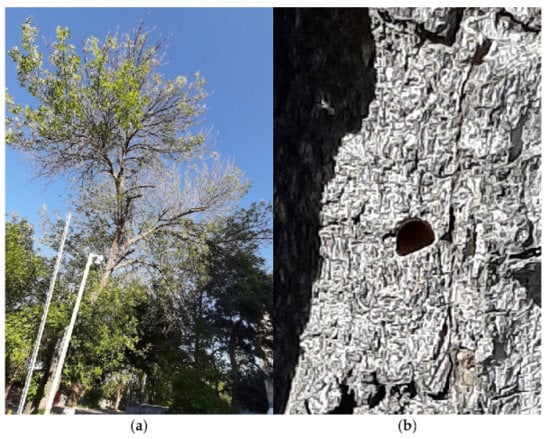
Figure 1.
The declined tree of Fraxinus pennsylvanica (a) with characteristic D-shaped exit holes of Agrilus planipennis (b) found at Dzerzhinskogo Street in Azov (47.115237 N, 39.422158 E).

Figure 2.
Current range of Agrilus planipennis in European Russia and Ukraine and results of our survey of ash trees in 2021. An—Anapa (Krasnodar Territory); Az—Azov (Rostov region); Ma—Makhachkala (Republic of Dagestan); Mi—Mineralnye Vody (Stavropol Territory); No—Novorossijsk (Krasnodar Territory); Py—Pyatigorsk (Stavropol Territory); Ro—Rostov-on-Don (Rostov region); Te—Temryuk (Krasnodar Territory); Vo—Volgograd (Volgograd region); Ni—Nikolskoe (Astrakhan region). RU—Russia; UA—Ukraine. The list of all localities where A. planipennis has been detected in Europe up to January 2022 is presented in Table S3.
- Ten declined trees of F. pennsylvanica with characteristic D-shaped exit holes were found in the City Park of Culture and Leisure (47.107899 N, 39.417889 E), and one dead adult of A. planipennis was found in the exit hole. This specimen in poor condition is in the second author’s collection. Its photo is in the Supplementary Material (Figure S1).
- One declined tree of F. pennsylvanica with D-shaped exit holes was found at Dzerzhinskogo Street (47.115237 N, 39.422158 E) (Figure 1).
The negative results of our surveys of ash trees in the foothills of the Caucasus and Rostov-on-Don city do not prove the absence of the pest there. Usually, the signs and symptoms of A. plenipennis are only detected several years after A. planipennis establishment [35].
The record in Azov (already mentioned in our previous article [13]) is the first record of A. planipennis in the Rostov region, the westernmost locality in the south of A. planipennis’s range and the closest locality to the Caucasus and to the Black Sea Region. Azov is about 300 km from the nearest previously known A. planipennis locality, about 250 km from the Caucasus mountains and less than 40 km from the North Caucasus region (NCS) in terms of the Biodiversity Information Standards [27]. Our data and the results of surveys conducted by other researchers in 2018–2021 clearly indicate that A. planipennis is quickly spreading to the south and approaching the Caucasus [5,7,9]. Now, the southernmost known localities of A. planipennis are Azov (Rostov region), Volgograd (Volgograd region) and Nikolskoe (Astrakhan region).
Agrilus planipennis often forms range enclaves far from the main part of its range [5]. For example, the enclave in St. Petersburg is 480 km from the nearest part of the main range in Central Russia, and the range enclave in the Lower Volga valley is about 350 km from the main range [5,36]. Rapid spread of this pest to the south and its tendency to form range enclaves indicate that A. planipennis might be found in the Caucasus in the next few years. Now, 19 years since the first record of A. planipennis in Europe, namely, in Moscow, it has spread over 600 km to the north and over 1000 km to the south. The average speed of spread is more than 50 km per year. The current range of A. planipennis in European Russia and Ukraine is much wider than the potential range predicted seven years ago by MaxEnt analysis of several climatic parameters [37].
Two species of ash trees are native to the Caucasus: F. excelsior and F. angustifolia [26]. The eastern part of F. excelsior’s native range consists of northern and southern parts, which are separated from each other by the steppe belt (Figure 3a) [26]. In 2003–2017, A. planipennis was recorded only in the northern part of the range [7,38]. However, in 2018–2021, it was recorded in the steppe belt between these two parts of the range of F. excelsior: in the Volgograd and Astrakhan regions [5,7]. In 2021, we also found it in Azov (Rostov region). This indicates that the pest is approaching the southern part of F. excelsior’s range.
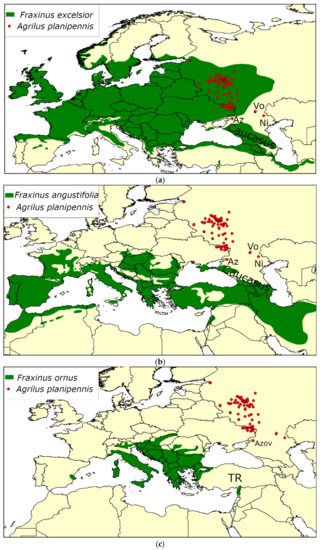
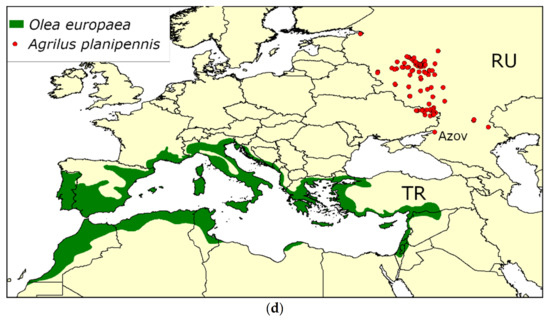
Figure 3.
Comparison of the current range of Agrilus planipennis in Europe with the native ranges of its host plants: Fraxinus excelsior (a), F. angustifolia (b) and F. ornus (c), and the main range of cultivation of Olea europaea (d). Most of the infestations refer to Fraxinus pennsylvanica.
The infestation in Azov as well as most of the infestations in European Russia and Ukraine refers to F. pennsylvanica. Artificial plantings and invasive populations of F. pennsylvanica in the steppe belt allow A. planipennis to spread in the territory, where no native ash species occur.
The finding of A. planipennis in Azov indicates that the pest is approaching the native range of another ash species: F. angustifolia (Figure 3b). The observations recorded in the Moscow Botanical Garden indicate that F. angustifolia is highly susceptible to A. planipennis [18]. The distance from Azov to the border of F. angustifolia’s range is about 150 km. Therefore, it is likely that the Caucasus will be the first region where A. planipennis enters the native range of F. angustifolia.
The potential spread of A. planipennis to the Caucasus is of concern for two reasons. First, ash trees are common there, and therefore A. planipennis is a serious threat to the local forest ecosystems including the unique ecosystems of Caucasus Nature Reserve [24,25]. Second, the ranges of F. excelsior and F. angustifolia in the Caucasus and Turkey are continuous (Figure 3) [38]; therefore, the Caucasus can become the gateway to Georgia, Armenia, Azerbaijan, Turkey and other countries of the Middle East and Southern Europe. While spreading to the south, A. planipennis is moving closer to the native range of F. ornus and the region of cultivation of Olea europaea (Figure 3).
3.2. Host Availability and Heat Availability as Limiting Factors of A. planipennis’s Potential Spread in the Caucasus
3.2.1. Distribution of Fraxinus spp. in the Caucasus
The presence of susceptible host tree species plays a major role in delineating the pest’s distribution [17]. Analysis of A. planipennis’s distribution in North America and China has shown that climatic variables alone are insufficient predictors of its potential distribution, and that the host plant presence should be included in models of its potential range [17].
Fraxinus excelsior is very common throughout this region: not only in the foothills, but also high in the mountains (Figure 4). There are 510 localities of this species in our database (Table S1); a total of 127 of them are situated above 1500 m a.s.l., and the highest locality is situated at an elevation of 2836 m a.s.l.
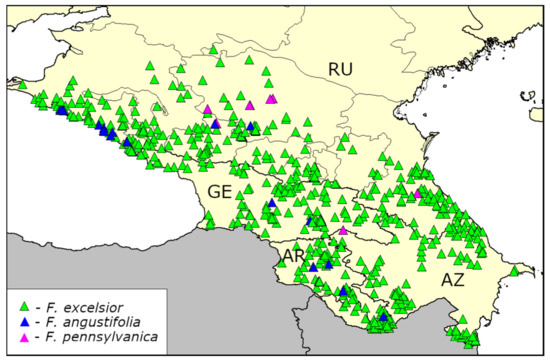
Figure 4.
Occurrences of ash trees in the Caucasus according to GBIF [24] and Agroatlas [25]. AR—Armenia; AZ—Azerbaijan; GE—Georgia; RU—Russia.
Fraxinus angustifolia is rarer and has a more restricted distribution in the Caucasus. There are 25 localities of this species in our database (Table S1); a total of 3 of them are situated above 1500 m a.s.l., and the highest locality is situated at an elevation of 1905 m a.s.l.
The alien ash species F. pennsylvanica is rare in the Caucasus region (unlike Central Russia). Only 13 localities of F. pennsylvanica in this region are recorded in GBIF [16]. The highest locality is situated at an elevation of 1315 m.
The data from GBIF [24] and Agroatlas [25] presented in Figure 4 show that Fraxinus spp. are common in the whole Caucasus. Therefore, host availability will probably not limit the spread of the pest in the region. However, A. planipennis cannot survive without its host plants; therefore, the local distribution of the pest will be limited by the Fraxinus spp. distribution.
The data on the occurrence of F. excelsior and F. angustifolia high in the mountains are consistent with the available literature [39,40]. According to Beck et al. [40], in the northern and western parts of its range, F. excelsior grows in lowland forests, while further south, it increasingly grows in mountainous areas and can be found at elevations of more than 2000 m. According to the description of the landscapes of the Caucasus by Abdurakhmanov [41], there is a narrow disjunctive belt of broad-leaved forests with F. excelsior and F. angustifolia on the southern slopes of the Armenian Highlands at elevations of 2600–2800 m.
3.2.2. Distribution of Heat Availability in the Caucasus
Heat availability is one of the main factors determining the distribution of insect species [42]. No cases of A. planipennis development in 3 or more years have been detected. The insect should complete its development in two years maximum [15,35,43]. It should accumulate the whole amount of heat necessary for full development in just two years. Therefore, a minimum threshold of heat availability exists.
The minimum AGDD10 recorded in the grid squares currently occupied by A. planipennis was 714° in Asia (native range), 705° in North America and 711° in European Russia [13]. Agrilus planipennis has never been recorded in localities with an AGDD10 below 700° in any part of the world [13]. This threshold could probably limit the distribution of A. planipennis in Northern Europe and in the mountains. Given the similar value on three continents and considering the range of AGDD10 worldwide is 0 to 8800 [13], it is hard to believe that the same value in three continents is just a coincidence.
Different approaches could be used to estimate the limitations of the potential range by heat availability. For example, Webb et al. [12] established the prognosis of the potential A. planipennis spread in the British Isles based on the calculation of the dates when the DD10 reaches 230 °C (the threshold of the early emergence of adults). They argued that the regions in which this threshold is not met within a calendar year or is met late in the year are unlikely to provide a suitable environment for A. planipennis to establish. The resulting map of the future distribution of A. planipennis in the British Isles is almost the same as our map for this territory using a different approach [13].
The results of the calculation of the AGDD10 for each grid square 0.25° × 0.25° (latitude × longitude degrees) in the Caucasus region (latitude from 38° to 45° N, longitude from 38° to 50° E) are presented in Table S2. There are 140 grid squares with an average AGDD10 in 2003–2020 that is less than the threshold of 700° (Figure 5).
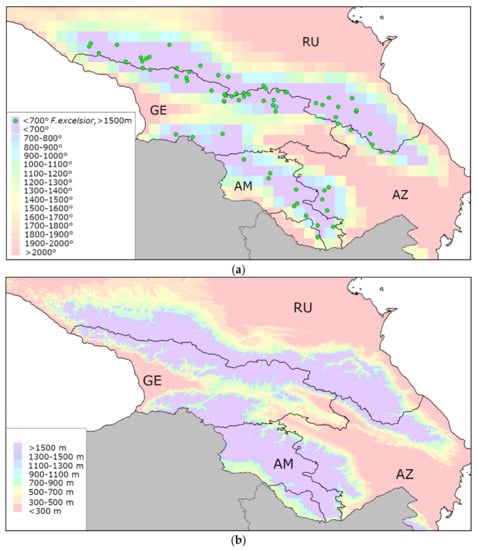
Figure 5.
Heat availability and relief of the Caucasus. (a) Heat availability: mean AGDD10 per year in 2003–2020 is indicated with colors; localities of Fraxinus excelsior situated in the grid cells with an AGDD10 below 700° are indicated with green dots. (b) Relief: elevation above sea level indicated with colors. AM—Armenia; AZ—Azerbaijan; GE—Georgia; RU—Russia.
Our database (Table S1) includes 101 localities of F. excelsior in the grid squares with AGDD10 < 700°, and 61 are situated above 1500 m a.s.l. (Figure 5a). We have two localities of F. angustifolia in the grid squares with AGDD10 < 700°, and one is situated above 1500 m.
The northern border of the potential range of A. planipennis in Europe does not coincide with the northern border of F. excelsior’s range: F. excelsior is common in the northern part of the British Isles and Scandinavia, where the AGDD10 is less than the threshold of 700° [13]. Comparison of ash trees distribution with heat availability distribution indicates the upper border of the potential range of A. planipennis in the Caucasus does not coincide the upper border of Fraxinus spp. range in these mountains. The resolution of the available temperature data (0.25° × 0.25°) [31] is not sufficient to calculate the exact AGDD10 in each locality occupied by Fraxinus spp. in the Caucasus, because heat availability can differ greatly within one grid square in the mountains. However, since both F. excelsior and F. angustifolia occur above 1500 m and are recorded in the grid squares with AGDD10 less than 700°, high mountain forests of the Caucasus could become refuges of ash trees from A. planipennis. The direct measurement of heat availability in the localities of Fraxinus spp. is necessary to verify this hypothesis.
It should also be noted that plasticity in the introduced range could yield novel phenotypes which are able to survive in new conditions different from those in its native range [44]. For example, A. planipennis in Canada survives severe winter colds not recorded in its native range [44]. This increases the uncertainty of the prognosis of the potential range based on climatic data from the native range.
3.3. Sentinel Trees in the Caucasus and Adjacent Regions Can Be Used for Monitoring the Impact of A. planipennis on F. angustifolia, F. ornus and Olea europaea
Since A. planipennis is spreading to the south, it is approaching the native ranges of F. angustifolia and F. ornus and the region of cultivation of Olea europaea. There are plantings of these species north of their main ranges (Figure 6). They are closer to the current range of A. planipennis: F. angustifolia occurs in the Rostov region, Crimea and the Black Sea coast of the Caucasus; Fraxinus ornus occurs in Crimea and Sochi; Olea europaea occurs in Crimea, in the Russian Caucasus in Sochi Arboretum and in Georgia in Akhali Atoni.
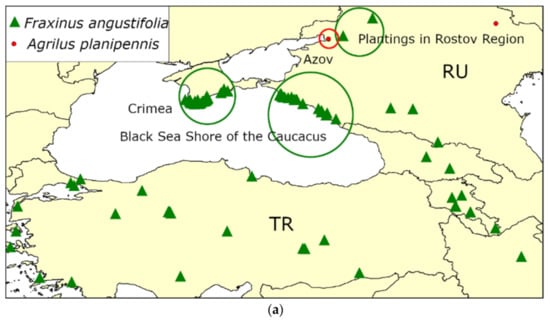
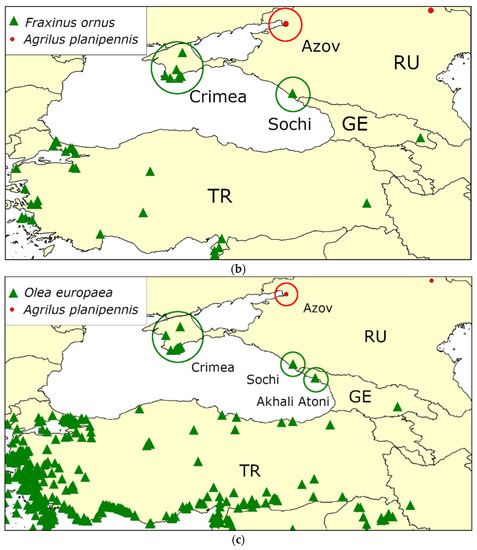
Figure 6.
Sentinel trees of F. angustifolia (a), F. ornus (b) and Olea europaea (c) in the Black Sea Region close to the current range of A. planipennis.
Roques et al. [45] proposed the concept of “sentinel trees”, i.e., the possibility to assess the pest risk for particular tree species by monitoring trees planted outside the native range of the tree species. When A. planipennis reaches these plantings of F. angustifolia, F. ornus and Olea europaea, they could be monitored to assess the pest risk for these tree species.
4. Conclusions
- At present, the southernmost known localities of A. planipennis in Europe are in the steppe belt of Russia: Azov (Rostov region), Volgograd (Volgograd region) and Nikolskoe (Astrakhan region). Artificial plantings and invasive populations of F. pennsylvanica have allowed A. planipennis to establish itself in the steppe belt, where no native ash species occur.
- Agrilus planipennis has not been recorded in the Caucasus, but it is quickly spreading to the south and may be found in the Caucasus in the next few years.
- The potential spread of A. planipennis to the Caucasus poses a serious threat to the local forests because native ash trees are common there. Moreover, it is a threat to the forests of the Middle East and Southern Europe, because the ranges of F. excelsior and F. angustifolia in the Caucasus and Turkey are continuous.
- Host availability will probably not limit the spread of A. planipennis in the Caucasus, because ash trees are very common throughout this region. Our calculations indicate that F. excelsior and F. angustifolia could escape from A. planipennis in the regions of the Caucasus above 1500 m, due to the low heat availability.
- We propose using Fraxinus angustifolia, F. ornus and Olea europaea growing north of the main ranges of these species as sentinel trees for the monitoring and pest risk assessment of these tree species.
Supplementary Materials
The following are available online at https://www.mdpi.com/article/10.3390/f13040541/s1, Table S1: Localities of Fraxinus spp. in the Caucasus (latitude 38°–45° N, longitude 38°–50° E); Table S2: Results of calculations: the mean AGDD10 per year in 2003–2020 in each grid square. Table S3: Localities, where the emerald ash borer A. planipennis has been detected in Europe by January 2022. File S1: Detailed description of the calculations of AGDD10. Figure S1: Photo of the specimen of A. planipennis collected in Azov City in 2021.
Author Contributions
Conceptualization, M.J.O.-B.; validation, A.O.B.; investigation, M.J.O.-B.; resources, A.O.B.; writing—original draft preparation, M.J.O.-B.; writing—review and editing, A.O.B.; visualization, M.J.O.-B.; funding acquisition, M.J.O.-B. All authors have read and agreed to the published version of the manuscript.
Funding
This research was funded by the Russian Science Foundation, grant number 22-24-00166.
Conflicts of Interest
The authors declare no conflict of interest. The funders had no role in the design of the study; in the collection, analyses or interpretation of data; in the writing of the manuscript; or in the decision to publish the results.
References
- Schans, J.; Schrader, G.; Delbianco, A.; Graziosi, I.; Vos, S. Pest survey card on Agrilus planipennis. EFSA Supporting Publ. 2020, 17, 1945E. [Google Scholar] [CrossRef]
- Haack, R.A.; Jendek, E.; Liu, H.; Marchant, K.R.; Petrice, T.R.; Poland, T.M.; Ye, H. The emerald ash borer: A new exotic pest in North America. Newsl. Mich. Entomol. Soc. 2002, 47, 1–5. [Google Scholar]
- Emerald Ash Borer Informative Network. Available online: http://www.emeraldashborer.info/ (accessed on 23 February 2022).
- Izhevskii, S.S. Threatening Findings of the Emerald Ash Borer Agrilus planipennis in the Moscow Region. Available online: http://www.zin.ru/Animalia/Coleoptera/rus/agrplaiz.htm (accessed on 23 February 2022).
- Volkovitsh, M.G.; Bieńkowski, A.O.; Orlova-Bienkowskaja, M.J. Emerald ash borer approaches the borders of the European Union and Kazakhstan and is confirmed to infest European ash. Forests 2021, 12, 691. [Google Scholar] [CrossRef]
- Musolin, D.L.; Selikhovkin, A.V.; Peregudova, E.Y.; Popovichev, B.G.; Mandelshtam, M.Y.; Baranchikov, Y.N.; Vasaitis, R. North-Westward expansion of the invasive range of emerald ash borer, Agrilus planipennis Fairmaire (Coleoptera: Buprestidae) towards the EU: From Moscow to Saint Petersburg. Forests 2021, 12, 502. [Google Scholar] [CrossRef]
- Orlova-Bienkowskaja, M.J.; Drogvalenko, A.N.; Zabaluev, I.A.; Sazhnev, A.S.; Peregudova, E.Y.; Mazurov, S.G.; Komarov, E.V.; Struchaev, V.V.; Martynov, V.V.; Nikulina, T.V.; et al. Current range of Agrilus planipennis Fairmaire, an alien pest of ash trees, in European Russia and Ukraine. Ann. For. Sci. 2020, 77, 29. [Google Scholar] [CrossRef]
- Meshkova, V.L.; Kucheryavenko, T.V.; Skrylnyk, Y.E.; Zinchenko, O.V.; Borysenko, A.I. Beginning of the spread of Agrilus planipennis Fairmaire (Coleoptera: Buprestidae) on the territory of Ukraine. Izv. St.-Peterbg. Lesoteh. Akad. 2021, 236, 163–184. [Google Scholar] [CrossRef]
- Meshkova, V.L.; Skrylnyk, Y.E.; Terekhova, V.V.; Kucheryavenko, T.V. Emerald ash borer (Agrilus planipennis) in Kharkiv Region. In Proceedings of the International Scientific and Practical Conference Modern Problems of Forestry and Ecology: Ways of Solution, Zhytomyr: Polissya National University, Zhytomyr, Ukraine, 7–8 October 2021; pp. 125–126. [Google Scholar]
- Commission Delegated Regulation (EU) 2019/1702 of 1 August 2019 Supplementing Regulation (EU) 2016/2031 of the European Parliament and of the Council by Establishing the List of Priority Pests. OJ L 260:8–10. Available online: http://data.europa.eu/eli/reg_del/2019/1702/oj (accessed on 23 February 2022).
- EPPO Global Database. Available online: https://gd.eppo.int/taxon/AGRLPL/categorization (accessed on 23 February 2022).
- Webb, C.R.; Mona, T.; Gilligan, C.A. Predicting the potential for spread of emerald ash borer (Agrilus planipennis) in Great Britain: What can we learn from other affected areas? Plants People Planet 2021, 3, 402–413. [Google Scholar] [CrossRef]
- Orlova-Bienkowskaja, M.J.; Bieńkowski, A.O. Low heat availability could limit the potential spread of the emerald ash borer to Northern Europe (prognosis based on growing degree days per year). Insects 2022, 13, 52. [Google Scholar] [CrossRef]
- Orlova-Bienkowskaja, M.J.; Bieńkowski, A.O. Minimum Winter Temperature as a Limiting Factor of the Potential Spread of Agrilus planipennis, an Alien Pest of Ash Trees, in Europe. Insects 2020, 11, 258. [Google Scholar] [CrossRef]
- Orlova-Bienkowskaja, M.J.; Bieńkowski, A.O. The life cycle of the emerald ash borer Agrilus planipennis in European Russia and comparisons with its life cycles in Asia and North America. Agric. For. Entomol. 2016, 18, 182–188. [Google Scholar] [CrossRef]
- Duan, J.J.; Schmude, J.M.; Larson, K.M. Effects of low temperature exposure on diapause, development, and reproductive fitness of the emerald ash borer (Coleoptera: Buprestidae): Implications for voltinism and laboratory rearing. J. Econ. Entomol. 2021, 114, 201–208. [Google Scholar] [CrossRef]
- Dang, Y.Q.; Zhang, Y.L.; Wang, X.Y.; Xin, B.; Quinn, N.F.; Duan, J.J. Retrospective analysis of factors affecting the distribution of an invasive wood-boring insect using native range data: The importance of host plants. J. Pest. Sci. 2021, 94, 981–990. [Google Scholar] [CrossRef]
- Baranchikov, Y.N.; Seraya, L.G.; Grinash, M.N. All European ash species are susceptible to emerald ash borer Agrilus planipennis Fairmaire (Coleoptera: Buprestidae)—A Far Eastern invader. Sib. J. For. Sci. 2014, 6, 80–85. Available online: https://сибирскийлеснoйжурнал.рф/upload/iblock/4be/4becfc1c0c3b3e232f28bd64691d9fac.pdf (accessed on 23 February 2022).
- Cipollini, D.; Rigsby, C.M.; Peterson, D.L. Feeding and development of emerald ash borer (Coleoptera: Buprestidae) on cultivated olive, Olea europaea. J. Econ. Entomol. 2017, 110, 1935–1937. [Google Scholar] [CrossRef]
- Majorov, S.R.; Bochkin, V.D.; Nasimovich, Y.A.; Shcherbakov, A.V. Alien Flora of Moscow and Moscow Region; KMK Publishing House: Moscow, Russia, 2012. [Google Scholar]
- Straw, N.A.; Williams, D.T.; Kulinich, O.A.; Gninenko, Y.I. Distribution, impact and rate of spread of emerald ash borer Agrilus planipennis (Coleoptera: Buprestidae) in the Moscow region of Russia. Forestry 2013, 86, 515–522. [Google Scholar] [CrossRef] [Green Version]
- Drogvalenko, A.N.; Orlova-Bienkowskaja, M.J.; Bieńkowski, A.O. Record of the emerald ash borer (Agrilus planipennis) in Ukraine is confirmed. Insects 2019, 10, 338. [Google Scholar] [CrossRef] [Green Version]
- Baranchikov, Y.N.; Seraya, L.G. The emerald ash borer on the way to Belgorod. Bot. Gard. Conserv. Int. Russ. Div. Newsl. 2019, 12, 91–94. [Google Scholar] [CrossRef]
- GBIF.org. 27 December 2021 GBIF Occurrence Download. Available online: https://doi.org/10.15468/dl.acfdb2 (accessed on 23 February 2022).
- Agroatlas. Available online: http://www.agroatlas.ru/ru/content/related/Fraxinus_excelsior/map/index.html (accessed on 23 February 2022).
- Caudullo, G.; Welk, E.; San-Miguel-Ayanz, J. Chorological maps for the main European woody species. Data Br. 2017, 12, 662–666. [Google Scholar] [CrossRef]
- Brummit, R.K. World Geographical Scheme for Recording Plant Distributions, 2nd ed.; Hunt Institute for Botanical Documentation: Pittsburgh, KS, USA, 2001. [Google Scholar]
- GBIF.org. 20 November 2021 GBIF Occurrence Download. Available online: https://doi.org/10.15468/dl.6qem9y (accessed on 23 February 2022).
- GBIF.org. 06 November 2021 GBIF Occurrence Download. Available online: https://doi.org/10.15468/dl.kfyb4p (accessed on 23 February 2022).
- GBIF.org. 05 November 2021 GBIF Occurrence Download. Available online: https://doi.org/10.15468/dl.jspy49 (accessed on 23 February 2022).
- Copernicus Climate Change Service. (C3S): C3S ERA5-Land Reanalysis. Copernicus Climate Change Service. Available online: https://cds.climate.copernicus.eu/cdsapp#!/home (accessed on 23 February 2022).
- Hijmans, R.J.; Guarino, L.; Cruz, M.; Rojas, E. Computer tools for spatial of plant genetic resources data: 1. DIVA-GIS. Plant. Gen. Res. Newsl. 2001, 127, 15–19. [Google Scholar]
- QGIS. 3.22.2 ‘Białowieża’. Available online: https://www.qgis.org/en/site/forusers/download.html (accessed on 23 February 2022).
- DIVA GIS. Free Spatial Data. Available online: https://www.diva-gis.org/Data (accessed on 23 February 2022).
- Haack, R.A.; Baranchikov, Y.; Bauer, L.S.; Poland, T.M. Emerald ash borer biology and invasion history. In Biology and Control of Emerald Ash Borer; Van Driesche, R.G., Reardon, R.C., Eds.; FHTET-2014-09 Department of Agriculture, Forest Service, Forest Health Technology Enterprise Team: Morgantown, WV, USA, 2015; Chapter 1; pp. 1–13. [Google Scholar]
- Selikhovkin, A.V.; Musolin, D.L.; Popovichev, B.G.; Merkuryev, S.A.; Volkovitsh, M.G.; Vasaitis, R. Invasive populations of the emerald ash borer Agrilus planipennis Fairmaire, 1888 (Coleoptera: Buprestidae) in Saint Petersburg, Russia: A hitchhiker? Insects 2022, 13, 191. [Google Scholar] [CrossRef]
- Flø, D.; Krokene, P.; Økland, B. Invasion potential of Agrilus planipennis and other Agrilus beetles in Europe: Import pathways of deciduous wood chips and MaxEnt analyses of potential distribution areas. EPPO Bull. 2015, 45, 259–268. [Google Scholar] [CrossRef]
- Orlova-Bienkowskaja, M.J. Ashes in Europe are in danger: The invasive range of Agrilus planipennis in European Russia is expanding. Biol. Invasions 2014, 16, 1345–1349. [Google Scholar] [CrossRef]
- Caudullo, G.; Houston Durrant, T. Fraxinus Angustifolia in Europe: Distribution, Habitat, Usage and Threats. In European Atlas of Forest Tree Species; San-Miguel-Ayanz, J., de Rigo, D., Caudullo, G., Houston Durrant, T., Mauri, A., Eds.; Publication Office of the European Union: Luxembourg, 2016; p. 97. e0101d2+. Available online: https://forest.jrc.ec.europa.eu/media/atlas/Fraxinus_angustifolia.pdf (accessed on 23 February 2022).
- Beck, P.; Caudullo, G.; Tinner, W.; de Rigo, D. Fraxinus Excelsior in Europe: Distribution, Habitat, Usage and Threats. In European Atlas of Forest Tree Species; San-Miguel-Ayanz, J., de Rigo, D., Caudullo, G., Houston Durrant, T., Mauri, A., Eds.; Publication Office of the European Union: Luxembourg, 2016; pp. 98–99. e0181c0+. [Google Scholar]
- Abdurakhmanov, G.M.; Krivolutsky, D.A.; Myalo, E.G.; Ogureeva, G.N. Biodeography Series: Higher Education; Moscow Akademia: Moscow, Russia, 2003; 480p, ISBN 5-7695-0976-7. [Google Scholar]
- Bale, J.S. Insects and low temperatures: From molecular biology to distributions and abundance. Philos. Trans. R. Soc. Lond. B. Biol. Sci. 2002, 357, 849–862. [Google Scholar] [CrossRef] [Green Version]
- Afonin, A.N.; Musolin, D.L.; Egorov, A.A.; Selikhovkin, A.V. Possibilities of further range expansion of the emerald ash borer Agrilus planipennis (Coleoptera: Buprestidae) in the North-West of European Russia: What factors will limit the invasive range? In Proceedings of the Arctic Congress 2016, Saint Petersburg, Russia, 12–16 September 2016; Moilanen, O., Ed.; University of the Arctic/University of Oulu: Oulu, Finland, 2016; p. 100. [Google Scholar]
- Duell, M.E.; Gray, M.T.; Roe, A.D.; MacQuarrie, C.J.; Sinclair, B.J. Plasticity drives extreme cold tolerance of emerald ash borer (Agrilus planipennis) during a polar vortex. Curr. Res. Insect Sci. 2022, 2, 100031. [Google Scholar] [CrossRef]
- Roques, A.; Fan, J.T.; Courtial, B.; Zhang, Y.Z.; Yart, A.; Auger-Rozenberg, M.A.; Denux, O.; Kenis, M.; Bake, R.; Sun, J.H. Planting sentinel European trees in Eastern Asia as a novel method to identify potential insect pest invaders. PLoS ONE 2015, 10, e0120864. [Google Scholar] [CrossRef] [Green Version]
Publisher’s Note: MDPI stays neutral with regard to jurisdictional claims in published maps and institutional affiliations. |
© 2022 by the authors. Licensee MDPI, Basel, Switzerland. This article is an open access article distributed under the terms and conditions of the Creative Commons Attribution (CC BY) license (https://creativecommons.org/licenses/by/4.0/).